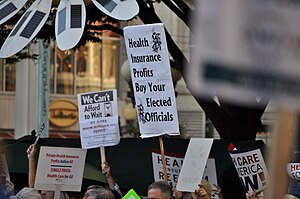One of the criticisms of the Affordable Care Act has been that few people actually know what is contained in the Act. Having spent untold hours reading the Act along with various independent assessments of the Act, I can testify to its immense complexity.
For example, in order to pay for the expansion of subsidized health insurance to millions of Americans, the Affordable Care Act adds numerous new fees and taxes on individuals’, employers and the health insurance industry. In 2010, there was a new tax on indoor tanning facilities (ok, so that is not a big deal, anyone who uses one of those deserves to be taxed). In 2014 there are new fees on employers and insurance companies, all of which have the potential of being passed along to consumers. In 2012 pharmaceutical companies that sell to the federal government are assessed what is called an annual fee (excise tax).
The various fees and taxes contained in the Act are among the few elements that are reasonably quantifiable. Other elements of the Act that are to reduce costs rely on assumptions of long-term success for well-meaning, but untried programs generally related to Medicare. To be successful, hospitals, physicians, other health care providers and Medicare beneficiaries must all work in a coordinated effort under new paradigms for providing health care.
Taking billions of dollars each year in new taxes impacts these organizations which then must find ways to mitigate this loss. It is tempting to simply dismiss such taxes as justified on highly profitable organizations. However, we should never forget that everything we do is connected to something else and every action has its consequences (think housing crisis). Generating revenue for some means a loss for others, a savings here means less revenue there and in some cases that may mean a loss of jobs, less invested in research or simply passing costs along to another party. When additional costs are imposed on employers, especially related to health benefits, it generally means greater cost sharing for employees and a shift in compensation from cash to employee benefit programs. Good benefits are valuable, but they don’t buy groceries or pay college tuition.
The following is excerpted from the IRS regulations with regard to the new fees on drug manufacturers (a very small sample of the hundreds of thousands, ultimately millions, of pages of regulations implementing the Affordable Care Act).
The aggregate fee amount each year for all covered entities (referred to as the applicable amount) is $2.5 billion for fee year 2011; $2.8 billion for fee years 2012 and 2013; $3 billion for fee years 2014 through 2016; $4 billion for fee year 2017; $4.1 billion for fee year 2018; and $2.8 billion for fee year 2019 and thereafter. The applicable amount for each year is allocated, using a specified formula, among covered entities with aggregate branded prescription drug sales of over $5 million to specified government programs or pursuant to coverage under such programs.
The specified government programs are the Medicare Part B program, the Medicare Part D program, the Medicaid program, any program under which branded prescription drugs are procured by the Department of Veterans Affairs, any program under which branded prescription drugs are procured by the Department of Defense, and the TRICARE retail pharmacy program (collectively, the Programs).
The annual fee for each covered entity is calculated by determining the ratio of (i) the covered entity’s branded prescription drug sales taken into account during the preceding calendar year to (ii) the aggregate branded prescription drug sales taken into account for all covered entities during the same year, and applying this ratio to the applicable amount. Sales taken into account means branded prescription drug sales after the application of the percentage adjustment table.
Tags: Medicare Part D, Medicaid, Patient Protection and Affordable Care Act, Affordable Care Act, branded drugs, fees on drug companies, fees imposed by PPACA, Prescription drug












Recent Comments